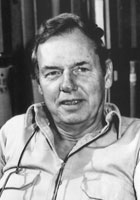 |
 |
|
 |
 |
 |
 |
 |
|
 |
 |
 |
 |

The Kensal E. van Holde Lectureship
7/25/08 - 9:00 AM - Lillie Auditorium
"Morphogenesis and Multicellularity in a Bacterium" - Richard Losick, Harvard University, HHMI Investigator
Richard Losick is the Maria Moors Cabot Professor of Biology, a Harvard College Professor and a HHMI Professor at Harvard University. He received his B.A. in chemistry from Princeton University and his Ph.D. in biochemistry from the Massachusetts Institute of Technology. He teaches the introductory course on molecular biology at Harvard College; as head tutor, he is responsible for the undergraduate concentration in biochemical sciences.
Dr. Losick is a member of the National Academy of Sciences, a member of the American Philosophical Society, a fellow of the American Academy of Arts and Sciences, a fellow of the American Association for the Advancement of Science, a fellow of the American Academy of Microbiology, and a former visiting scholar of the Phi Beta Kappa Society. He is a recipient of the Selman A. Waksman Award in Microbiology from the National Academy of Sciences. In addition, he is on the editorial boards of Science and Cell.
Dr. Losick’s laboratory studies development in the spore-forming bacterium Bacillus subtilis. B. subtilis undergoes an elaborate cycle of cellular differentiation that culminates in the formation of a dormant cell type, the spore. Spore formation involves the transformation of a vegetative cell into a two-compartment sporangium by asymmetric division. The compartments receive an identical chromosome yet have dissimilar developmental fates involving differential expression of distinct sets of genes. We seek to elucidate the entire regulatory circuit that governs entry into sporulation, cell-specific gene expression, and the linkage of gene expression to landmark events in morphogenesis. Other topics of interest are protein subcellular localization, morphogenesis, chromosome segregation, intercellular signaling, and the formation of architecturally complex communities of cells.
 |
|
|
|
Kensal E. van Holde received both B.S. and Ph.D. degrees from the University of Wisconsin. Trained as a physical chemist, his early interests lay in the synthetic polymer field, which led to initial employment in industry. Dr. van Holde returned to academia in 1957, as an assistant professor at the University of Illinois. There he met J. Woodland Hastings, who asked him to join the faculty of the MBL Physiology course in 1962. He served as a course faculty member for five years, and later as course director from 1977 to 1981.
His experiences in the Physiology course marked a turning point in Dr. van Holde’s career. The enthusiasm of the staff and students at the MBL fired an excitement for biological research that dominated all of his subsequent work. Indeed, the two major themes of his career—the structure and function of oxygen transport proteins, and the fine structure of chromatin—both had their seeds in work conducted at the MBL.
This fascination with the MBL and a love for Woods Hole has led the van Holde family to return nearly every summer for more than 40 years. During that time Dr. van Holde has served on both the Board of Trustees and Executive Committee of the MBL. He is also a member of the American Academy of Arts and Sciences and the National Academy of Sciences.
|
| |
  |
|
 |
 |
|